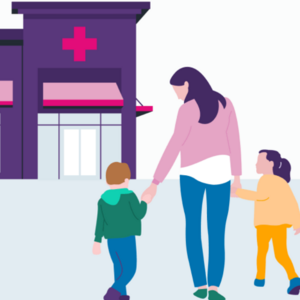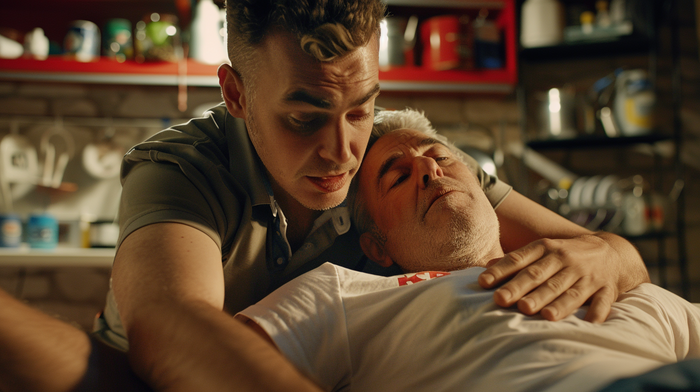
Feel better faster. Get care today.
From the clinic or your couch. Find high quality, same-day urgent care for you and your kids. Book an urgent care visit today.

Cardiopulmonary resuscitation (more commonly called CPR) is a life-saving technique that is used to revive someone who has stopped breathing and has no heartbeat, according to the Red Cross. It is a critical skill that can make the difference between life and death in an emergency. Knowing how to perform cardiopulmonary resuscitation while someone else calls 911 can help save the life of a loved one, a co-worker, or even a stranger.
Cardiopulmonary resuscitation (CPR) involves a combination of chest compressions and rescue breaths to circulate oxygenated blood throughout the body, according to the Red Cross. They note that the purpose of CPR is to maintain blood flow to vital organs such as the brain and heart — which can help prevent permanent damage or death. It is important to understand that CPR alone is not enough to restart the heart (according to the Red Cross), but it can keep the person alive until more advanced medical interventions (like defibrillation and cardiac medications) can be administered.
According to the Red Cross, CPR has the best chance of saving a life if someone starts it as soon as possible after the person has collapsed. Whether you are a healthcare professional or a helpful bystander, understanding the basics of CPR can help you be prepared to act in an emergency.
CPR can be performed on adults, children, and infants. In fact, the American Heart Association recommends that everyone learn how to perform CPR in case of an emergency. Basic CPR training can usually be found by contacting a local hospital and typically includes learning how to recognize the signs of cardiac arrest, performing chest compressions, and administering rescue breaths.

From the clinic or your couch. Find high quality, same-day urgent care for you and your kids. Book an urgent care visit today.
Cardiopulmonary resuscitation (CPR) is a life-saving technique that is performed when a person's breathing or heartbeat has stopped, according to the American Heart Association. CPR is done to keep the blood flowing to vital organs until medical help arrives.
CPR should be performed immediately if a person is not breathing or has no heartbeat, according to the Red Cross. The following are some situations where CPR may be required:
The Mayo Clinic states that it is important to note that CPR should only be performed on a person who is unresponsive and is either not breathing or has no heartbeat. If the person is responsive (awake and breathing), CPR is not necessary.
Preparing for CPR can help you act quickly and confidently in an emergency situation. Here are some steps you can take to prepare in case you ever have to perform CPR from the American Red Cross and the American Heart Association (AHA):
CPR courses are available through various organizations, including the American Red Cross and the AHA. These courses can teach you the proper techniques for performing CPR on adults, children, and infants. They can also teach you how to use an automated external defibrillator (AED) and how to perform a Heimlich maneuver to help someone who is choking.
After completing a CPR course, you can get certified in CPR. Certification shows that you have demonstrated the skills and knowledge necessary to perform CPR effectively. Certification is typically valid for two years, after which you will need to renew it. Recertification is recommended to refresh your skills and help you learn the latest techniques in CPR, according to the AHA.
Like any skill, performing CPR requires practice. Consider practicing with a CPR manikin or attending a refresher course to keep your skills sharp.
In an emergency situation, it can be easy to forget the proper steps for performing CPR. Keeping a reference guide handy can help you remember what to do.
In an emergency situation, it's important to stay calm. Take a deep breath, assess the situation, and remember your training. Acting quickly and confidently can help save a life.
By taking these steps to prepare for CPR, you can be ready to act quickly and effectively in an emergency situation.
CPR is an emergency procedure that can save a person's life by restoring their breathing and heartbeat, according to the AHA. Knowing how to perform CPR can mean the difference between life and death in an emergency situation. Here's what you need to know to perform CPR correctly, according to current AHA guidelines:
Performing CPR can be physically exhausting, so if possible, switch off with another person every 2 minutes to maintain effective compressions.
The American Heart Association recommends using the letters C-A-B to help people remember the order to perform the steps of CPR:
Performing CPR on a child can be a highly emotional task, but it is important to know what to do in case of an emergency.
Here are the steps to perform CPR on a child from the AHA:
Continue with cycles of 30 compressions and 2 rescue breaths until emergency medical services arrive or the child begins to breathe on their own.
Infant CPR is slightly different because infants are so much smaller and more fragile. Here are the AHA recommendations for infant CPR:
Continue cycles of compressions and breaths: Do 30 compressions followed by two breaths. Repeat until the baby starts breathing or help arrives. Remember to call for help as soon as possible and continue CPR until the baby starts breathing or help arrives.
While CPR can be a life-saving measure, it is not always successful in restarting the heart. If the person's heart does not start beating again after CPR, a medical team may declare them deceased. If the person's heart does start beating again, they will need medical treatment for whatever reason caused their cardiac arrest and may need some time for their body to recover, notes the AHA.
If the person is unresponsive, not breathing normally, and has no pulse, call 911 immediately. This is a medical emergency and time is of the essence.
If the person is conscious but experiencing chest pain, shortness of breath, or other symptoms of a heart attack, you should also call 911 right away. These symptoms may indicate a serious medical condition and prompt medical attention is necessary.
For a medical emergency, dial 911 or visit your closest emergency room immediately.
The purpose of CPR is to maintain blood flow to vital organs like the brain and heart when someone's breathing and heartbeat have stopped, until more advanced medical help arrives.
CPR should be performed by anyone who is trained, immediately when a person is not breathing or has no heartbeat.
Key steps include checking for responsiveness, performing chest compressions, opening the airway, giving rescue breaths, and repeating the cycle until help arrives.
Preparation can include taking a CPR course, getting certified, practicing regularly, keeping a reference guide handy, and learning to stay calm in emergencies.
After performing CPR, the person should be given medical treatment for the cause of their cardiac arrest. If the heart does not restart, the medical team may declare the person deceased.